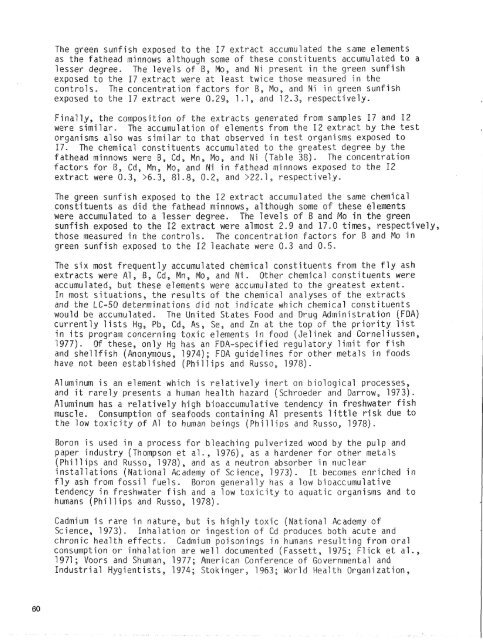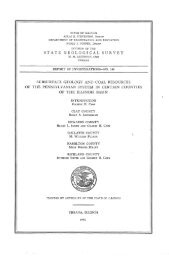Chemical and toxicological properties of coal fly ash - University of ...
Chemical and toxicological properties of coal fly ash - University of ...
Chemical and toxicological properties of coal fly ash - University of ...
- No tags were found...
Create successful ePaper yourself
Turn your PDF publications into a flip-book with our unique Google optimized e-Paper software.
The green sunfish exposed to t t accumulated e same elementsas the fathead minnows althoug ese constitue accumulated to alesser degree.resent in the green sunfishexposed to thecontrols. Theexposed to the IFinally, the composition <strong>of</strong> the extracts generated from samples I7 <strong>and</strong> I2were similar. The accumulation <strong>of</strong> elements Prom the I2 extract by the testorganisms also was similar to that observe in test organisms exposed to17. The chemical constituents accumul ated to the reatest degree by thefathead minnows were B, Cd, Mn, NO, <strong>and</strong> 8). The concentrationfactors for 5, Cd, Mn, Ma, <strong>and</strong> Ni in fat posed to the 12extract were 0.3, >Q.3, 81.8, L2, <strong>and</strong> >22.1, respectively.The green sunfish exposed to the I2 extract accumulated the same chemicalcsnsti tuents awere accumul atsunf i sh expose7.0 times, respectively,those measuredors for B <strong>and</strong> Mo ingreen sunfishThe six most frequently accumulated chemical constituents from the <strong>fly</strong> <strong>ash</strong>extracts were Al, B, C , Mn, MO, <strong>and</strong> i, Other chemical constituents wereaccumulated, but these elements were accumulated to the greatest extent.In most situations, the results <strong>of</strong> the chemical analyses <strong>of</strong> the extracts<strong>and</strong> the LC-50 determinations did not indicate which chemical constituentswould be accumulated. The United States Food <strong>and</strong> Drug Admini tration (FDA)currently lists Hg, Pb, Cd, As, Se, <strong>and</strong> Zn at the top <strong>of</strong> the riority listin its program concerning toxic elements in food (Jelinek <strong>and</strong> Cornel i ussen,77). Of these, only Hg has an FDB-specified regulatory limit for fishd shellfish (Anonymous, 1974); FDA guidelines for other metals in foodshave no% been establishe (Phi l l ips <strong>and</strong> Russo, 1978).Aluminum is an element<strong>and</strong> it rarely prAluminum has a ronsumption <strong>of</strong>the low toxicity <strong>of</strong> A1is relatively inert on biological processes,raeder <strong>and</strong> Darndency in fresBoron is used in a process for bleaching ulverized wood by the pulp <strong>and</strong>paper industry (Thompson et al., l976), a(Phi 11 ips <strong>and</strong> Russo, l978), <strong>and</strong> as a neutroinstallations (National Academy <strong>of</strong> Science,<strong>fly</strong> <strong>ash</strong> from fossil fuels. Boron generallytendency in freshwater fish <strong>and</strong> a low toxicity to aquatic organisms <strong>and</strong> tohurnans (Phi 11 ips <strong>and</strong> Russo, 1978).Cadmium is rare in nature, but is highly toxic (National Academy <strong>of</strong>Science, 1973). Inhalation or ingestion <strong>of</strong> Cd produces both acute <strong>and</strong>chronic health effects. Cadmium poisonings in urnans resulting from oralconsumption or inhalation are well documented ( assett, 1975; Flick et al.,1971; Voors <strong>and</strong> Shuman, 1977; American ConIndustrial Hygientists, 1974; Stokinger, 1
















